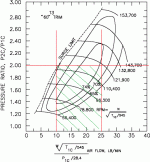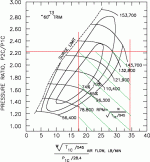So let me ask you this. Isn't there a limit in the amount of air a turbo (or dual turbos in my case) can provide to an engine when the engine wants to use more air than the maximum amount of boost reaches equilibrium (or worse, boost drops when that max limit is reached) with the amount of air the engine can use? The way I understand it, boost is simply the fact that the turbos are providing more air to the engine than the engine can take in naturally aspirated. There has to be a limit of how much boost a turbo can provide based on how much air the engine can to use. In a properly designed setup, I guess the turbos would be sized such that this limit is never reached. But as should be evident from this thread, very little in any design (being kind with that definition) thoughts were ever what you would consider as "proper".
In other words, what are the signs that a turbo system is too small for the engine? Max boost as dictated by the wastegate spring is never reached? Or in a less severe case, max boost is reached, but as red line is approached, boost peters out? Or turbos go *boom* because they are spun beyond their design limits?
boost is only a measurement of resistance of the intake tract of an engine at a specific flow rate.
I've been doing a little bit more research on how to properly pick a turbo for a gas engine. here are some formula's and guides to check and see what you have.
FIRST off, we have to find out the Volumetric efficiency of the engine at peak RPM. this can be checked in the tuning tables and normally will be ~90% on an LS motor, and at 98+% at the rpm where peak TQ is achieved.
for this example we will use 90%. once you find the "correct" value you can substitute it in the equation.
First we need to calculate the engine air flow rate (CFM). The formula for this is:
CFM = (L x RPM x VE x Pr) / 5660
Where L = engine capacity in liters
RPM = maximum engine speed (we'll adjust this later)
VE = engine volumetric efficiency. (we will use 90% for now)
Pr = pressure ratio
To calculate the pressure ratio you need to know what boost pressure you want to run and then plug that into the following formula:
Pr = (14.7 + Boost) / 14.7
SO, let's plug in some numbers and then apply them to the compressor maps (I have found one for a T-3 "60". Say we want to run 10psi of boost. The pressure ratio comes out to be (14.7 + 10) / 14.7 = 1.68
Now lets calculate airflow. I found it's best to calculate airflow at at least two different RPM points as this will allow you to figure out low boost and high boost ranges throughout the specified RPM band. For our example, let's say we want to have full boost by half of max RPM. Redline on your motor is 6000RPM (i know it might be more but I am using theoretical #'s here). So we'll calculate airflow for 3000RPM (assuming this is the RPM that boost begins to build) and 6000RPM, and then see which map works out best for these values. We'll choose 90% for volumetric efficiency (VE).
For 6000RPM:
CFM = (7.0 x 6000 x 90 x 1.68) / 5660 = 1122CFM or 78.62lb/min. To convert this value to lb/min take CFM and divide by 14.27.
For 3000RPM:
CFM = (7.0 x 3000 x 90 x 1.68) / 5660 = 561CFM or 39.3 lb/min. As a side note, since half the RPM will result in half the airflow, 561CFM is indeed half of 1122
we will then need to cut these numbers in 1/2 since there are 2 turbo's providing flow. so 39.3lb/min for the upper limit and 19.65lb/min for the lower limit.
first is a map of a T-3 "60" trim sourced from
www.turbocharged.com with the above variables blotted on it.
1.68 P/R, lower RPM flow at 19.65lb/min and upper limit at 39.9lb/min
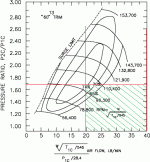
just for fun, I plotted the same over a T-4 "54" trim compressor map.
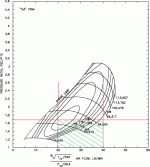
the shaded green area is what the engine requires, assuming the VE% is correct along with the desired 3000RPM lower limit and 6000RPM upper limit.
once you find a map where the top right corner of the box, or where the lower CFM # and the P/R intersect, is not to the left of the surge line, the turbo is OK for the application and is not too big. Ideally you want to be in the center of the compressor map throughout the entire range, having the "islands" in there and the center one is the best efficiency output of the turbo.
now, by looking at the T-3, you can see that you are completely out of the efficiency range at that given Boost pressure and RPM.
lets take a higher PSI and plot them across the T-4 and T-3 charts.
for this pressure ratio we will go with 1.9, this equals 12.8PSI from the compressor.
For 6000RPM:
CFM = (7.0 x 6000 x 90 x 1.9) / 5660 = 1268CFM or 88.9lb/min. To convert this value to lb/min take CFM and divide by 14.27.
For 3000RPM:
CFM = (7.0 x 3000 x 90 x 1.9) / 5660 = 634CFM or 44.5 lb/min.
divide by 2, since there are 2 turbo's and upper limit is 44.45lb/min and lower 22.25lb/min
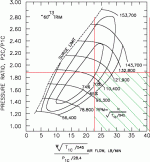
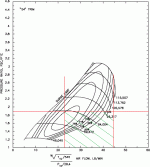
as you can see, on both T-3 maps, once you build boost you are completely off the map on being anywhere close to the efficiency range for the specified volume the turbo can put out.
the T-4 shows a better comparison on where it should be, but it still runs out of volume before peak RPM.
it is hard to find a turbo that the maps work well with a "low" boost numbers like above. I am sure there is one out there but it will take a bit of research....
BTW, i still claim to not be an expert. just slightly knowledgeable enough to get myself in trouble.





